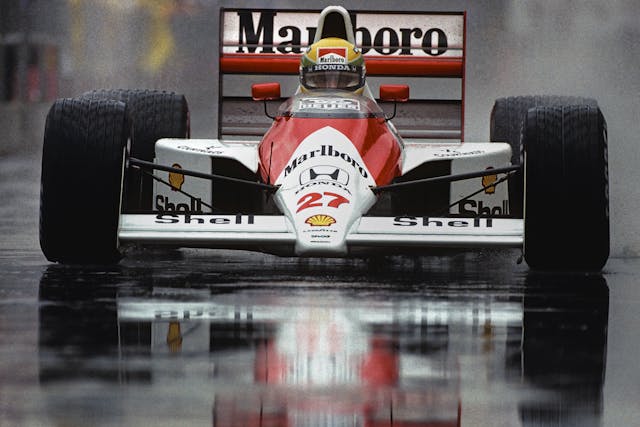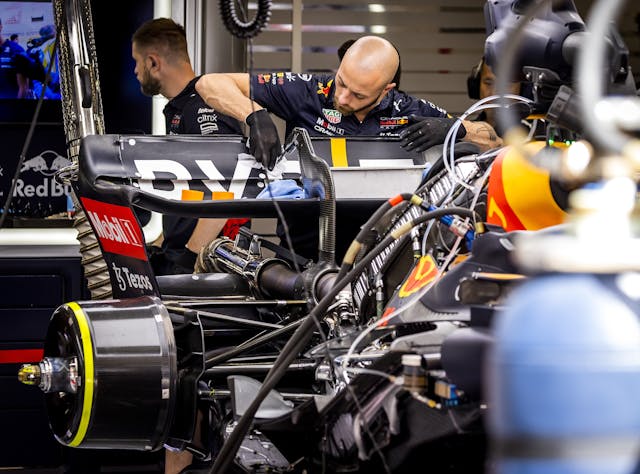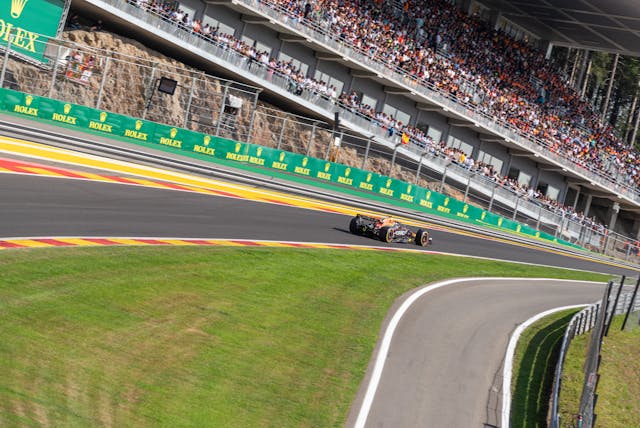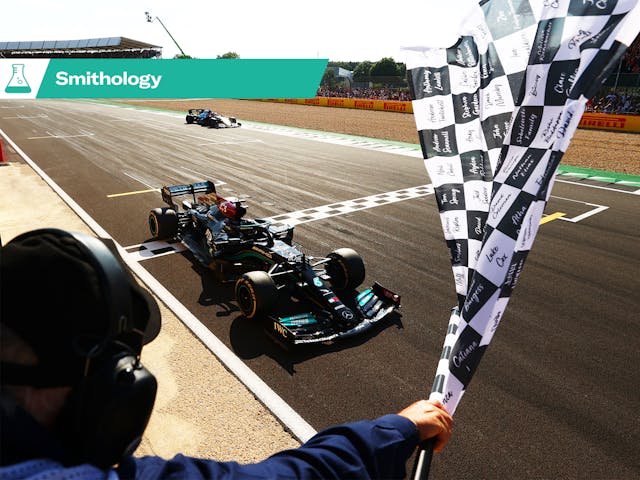Smithology: It makes sense when you see it
Top teams spend hundreds of millions annually. The cars they design from scratch resemble grounded airplanes, play 180-mph games of chess. Corners subject drivers to as much as 6 g.
Still: Formula 1 can be soporific. Some races are great. Most are great to nap to.
Blame, partly, the nature of the beast. F1 has always had overdogs and processional races. But there is hope. The sport found new owners in 2017. Those people appear to understand the problem. Many of their changes have orbited the production and management of aerodynamic downforce.
Downforce is the make-or-break core of an F1 design, invisible and massively complex. Winglike surfaces “fly” a car into the ground, aiding grip. That grip can mask a driver’s genius or fluff a lame talent, and its development impacts everything from mere passing to a whole season’s narrative. Year after year, each race result hinges on a discipline that 99 percent of fans find indistinguishable from magic.
That other one percent, though! If you meet someone in that group, ask questions. I recently fell into a Zoom call with a retired engineer friend who qualifies. This man spent his career in classified projects at a major aerospace defense contractor. Let’s call him Edward. We have each loved F1 for decades.
How, I asked, does one of my favorite sports present when bleeding-edge flight is your home turf? Does knowing air math make the racing more compelling? Can you effectively explain flow detachment to a man whose byline has supported criminal overuse of the word “goofus”?
What follows is an edited transcript of a casual chat. Two fans talking problem-solving, mass appeal, and deadline aerodynamics. I marveled at so much—not least how such a forward-thinking sport can pull so many of its problems from the past.
Chiefly, no one fell asleep.
***
Sam Smith: You didn’t work in racing, but your day job gave you an outsider lens about as evolved as it gets. How did you discover F1?
Edward: It was in high school, about 1964. I was interested in cars. I’d go to the grocery store and buy Car and Driver and Road & Track. There were race results in the back.
SS: Did you always want to be an engineer?
E: Yes, pretty much. I was probably 10 years old when Sputnik went up. We felt that the U.S. was behind in science and technology. There was a push to rectify that situation. My aptitude and training went into what we [now] call STEM, and Formula 1 seemed very interesting from a technology point of view.
SS: The progress leaps in that era are so cool. Until the transistor came along, most human inventions, you take them apart, you see how they work. Cars were no different, the curve was just slower. Computing power had to get cheap enough and fast enough to manage the machine.
E: When I took electrical engineering as undergraduate, we did all our calculations with tubes. Transistors hadn’t worked into our curriculum yet.

SS: I didn’t find F1 until middle school. Early Nineties. Long after the revolutions that prompted the sport to narrow: whole cars working like one giant wing, sliding skirts. Banned because the FIA felt cornering speeds were becoming unsafe. And then those speeds came anyway, by other paths, albeit later, in cars safer to crash.
We want to root for triumphs we can understand. The underbody tunnels on a Lotus 79—they make sense when you see them.
E: With those first ground-effects cars, you could see the tunnel, you could see the sides. You could see they were trying to seal the sides to the racetrack [with skirts, to keep the air in], you could tell what’s going on. They had very simple and very small front and rear wings.

SS: At some point after … writers call it “losing the reader.” The NFL knows exactly who its audience is, what they want. Formula 1 seems to be perpetually asking.
E: That is what puzzles me. Who is the sport [now] for? Is it for the guy watching the race on his couch? Because almost no one knows about or cares about the details of the aerodynamics, from the time that you joined in 1990s. And almost no one knows or really cares about the hybrid engines. If you asked me to draw a layout of a hybrid engine on Formula 1 car, I couldn’t do it. I have no idea what’s under the hood.
SS: It’s so common in racing. Management gets stodgy, the audience shrinks for one reason or another, everyone gets reluctant to take chances. They just want to stem the bleeding. They lose how things look from TV or the stands.
E: I agree with you.
SS: When you found F1, in the Sixties, it was relatively simple. Did your perspective change over time?
E: I think the 3.0-liter period from—what was it, 1966 to 1986—to me, that was the golden era. That included the Lotus 79. Then it’s like Formula 1 got lost, and I can’t tell why. Today, I look at it and think, “This [rule] change is being made for Mercedes.” Maybe 15 years ago, you could say, “This change is being made for Ferrari.”
SS: Some stage management is necessary; too much is poison.
E: Somewhere along the way, we got into these technologies that, I don’t know who it serves … I can’t tell what the technology is. I can’t see the aero under the car. I could see it on the bizarre wings that we had under the [2021] rule book. The engines have relatively no interest to me, and they’re frozen. I have no idea even how the power goes to the axles, what the differential looks like, how that all goes together.

SS: No racing rules are perfect. But there was a point where sanctioning bodies everywhere shifted from “see what’s possible” to reactionary. One of those approaches resembles your business—a way to go places you haven’t been. The other is basically pacing in circles.
E: For 40 years, [I’ve] always worked on advanced systems. I never worked on developmental or production systems. I’ve been working with advanced technology my whole career.
SS: The cars change so much over a season. Does a background in similar systems help you care?
E: Oh, absolutely. I come from a perspective where there are no [man-made] rules. The rules are the laws of physics. If you want to build a plane with forward-swept wings, highly unstable, and control it with software, there’s nobody to tell you can’t. The only thing that limits you is budget. As we move into a budget-limited Formula 1, I think that’s a good thing.
SS: Sometimes they’ll make new aero parts during a race weekend. Fly them in. It takes massive context to understand why. Does an aerodynamics background make a difference?
E: Yes. If you’re [someone like Red Bull chief tech officer] Adrian Newey, you know what they’re trying to do. If you’re lesser people, no. You’re guessing.
The front wings got to the point where I think they were fairly understandable. It was the bargeboards and the other things along the side of the car—they got to be more confusing.

SS: The corollary is, unlimited racing tends to come apart at the seams. The 1970s Can-Am, Porsche builds a hugely dominant car, no one can keep up, it kills the series. Do you think there’s a way forward that pulls the best from each camp?
E: Pages removed from the rule book would be what I would try. So that the smart guys can build something, designed to cost, superior than the rival.
SS: I’ve been watching the Netflix F1 documentary, Drive to Survive. F1 cars are constantly being reengineered, but that process is basically absent from the narrative. Secrecy matters, of course, but they also know the tech just isn’t that interesting to normal people.
There’s a parallel in how the rules keep reducing the choices teams can make. Has that served the sport?
E: I don’t think [so] at all. We’ve eliminated tire competition. We’re down to one tire supplier. We’ve essentially eliminated engine competition. Over time, the engine suppliers have pretty much gotten to a level playing field, and it’s not going to change until they introduce a new engine formula. Suspensions are what they are. The only thing that’s left is aero.
If you want to build a better car, the only way is to have better aero than the other guy. It’s not like Mercedes got dumb over the last year. They just went down the wrong path, aero-wise.
SS: You once told me F1’s problem is how “aero is about vortex control.” A mutual friend defined it as, “making false body surfaces out of large captured vortices of air.”
E: The problem with a formula car is, you’ve got four exposed wheels, tires turning, and between them a great open space, between the back of the front wheel and front of the back wheel. If you leave that area untreated, the tires are going to send all kinds of turbulent junk into that area. [That turbulent air is] going to hit the rear tire, get reflected off, go to the wing. Nothing’s going to work.
If you can produce a vortex that wants to live in that space and persist in that space, then the air coming up over the tire will also go up over the vortex. It’s effectively filled in that area with stagnant captured flow.
The flow isn’t stagnant in the sense that it’s not moving. It’s moving within itself. But it’s not moving out from between the wheels, and it’s captured.

SS: When you say captured …
E: You drop some popcorn into that space … it would never come out, because new air is not coming in to sweep it clean.
That happens in the aerospace industry. One of the biggest problems can be to build a bomber, and the bombs will not fall [from the bomb bay]. We would—
SS: Wait, really?
E: Yes. The B-1, in particular, had that problem. They had to build very special ejectors to eject them very hard. Some of the weapons would break when they tried to eject them.
SS: I think vortex, I think whirlpool. This is a parked chunk of air that—
E: Does not leave. When the air looks at the car, it sees a filled-in space. It doesn’t see an opening between the wheels.
SS: Everyone seemed happy when bargeboards disappeared for this year—they were there to control vortices?
E: Yes. Either create them, or to capture them, or who knows what?

SS: The cliché is that air moves like water. Which isn’t true, but …
E: There’s enough similarities that it’s useful to think in those terms.
SS: That mutual friend once told me about walking an amateur race paddock with you. You pointed to some homebuilt wing and said, “air doesn’t want to do that.” [laughs] What does air want to do?
E: We’re used to thinking about the car being stationary and air moving over it. Think about it the other way: Here is air, it’s just sitting around, it’s made up of a bunch of molecules. The molecules have temperature, so they’re constantly bouncing into each other. By bouncing into each other, they know what’s going on, and they’re essentially moving at speed of sound. I think speed of sound should be called the speed of pressure regulation, because the collision frequency of the molecules is what determines the speed of sound.
Now, an object starts coming in. [Imagine] a ball.
Some of those molecules are hitting off the front of the ball, and they are going, at the speed of sound, to run into their brothers. A whole group of molecules knows that this ball is coming before it even gets there. Other ones are bounced up a little bit, bounced down a little bit, to get out of the way of the ball.
After the ball leaves, the pressure behind the ball is lower, so some of the molecules want to fill in. That’s basically what happens in all aerodynamics for incompressible, non-viscous flow, but the problem with nature is that there is viscosity in all liquids and gasses.
They want to stick. When they start sticking is when bad things happen.

SS: What do you mean by stick?
E: Let’s go back to the water thing. You’re trying to dry out a pitcher. You turn it upside down. You turn it back up, there’s still water in there, because the water has stuck to the glass. Air does the same thing. Molecules stick to the surface of the ball. Their stickiness is transferred to their friends who are nearby.
Gradually, a layer of air that has its own behavior is forming separately on that ball. Eventually, that thickness gets too thick. There’s too much energy in it, and it’s going to break off from the ball. That’s detachment. Now, one of the tricks in nature is that first, it’ll detach on one side. That vortex comes off, then starts building up again. Then the bottom side is out of phase. First, the top vortices comes off, then the bottom vortices.
Now, behind this ball, you’ve got a string of vortices coming off the back. When you drive down the interstate behind a tractor-trailer, under the right conditions, you can feel that. The car’s buffeting right and left. That’s those vortices shedding off the sides of the trailer.
SS: Do these things always move predictably?
E: Vortices can be teeny-tiny, and vortices can be the scale of the thing that’s causing them. When the ball goes through the air, the principal vortex will be about the same size as the ball. It’ll be [followed by] smaller vortices.

SS: Turbulence in an airliner—bucking and jolting—feels random. It never is, but…
E: The scarious turbulence is from natural turbulence in the air; [the only options are] fly at a different altitude or around it. The second type of turbulence is in the air in contact with the skin. In an airplane, it’s just constant rumble, strumming on the skin of the airplane. That’s the boundary layer with the turbulence, banging on the aluminum.
That’s another form of turbulence. The third form is very large vortices that are developed by the planes themselves. When you’re flying in an airplane and you want to land, the controller will tell you there’s a heavy in front of you. That means it’s a big plane—there’s going to be large vortices off that airplane.
SS: It’s crazy how long that stuff sticks around. A 747 can land and taxi off, and 30 seconds later, its vortices are still over the runway, waiting to flip a Piper Cub, right?
E: Yes. It’s amazing how long those can persist.
SS: Why do they?
E: There’s no force to stop it. If you accelerate a fluid, it’s going to stay in the immediate speed / rotation condition until it runs into something to decelerate it.
SS: The vortices detaching from a car—does the flow stay relatively…
E: No, it breaks it up. A normal vortex causes drag. A lot of car manufacturers now, to prevent formation of large vortices, [they work] even with subtle shape of a trunk lip … try to get the air to come down, break up vortices, reduce drag. Because it’s all about drag [and] mileage, for a street car.
SS: I adore history, but moving forward trumps living in the past. Does your business carry any reverence for the old? Say, people bemoaning that Lockheed’s Skunkworks isn’t what it was in the 1960s, under Kelly Johnson?
E: Well, you learn lessons from the past, but no one is saying, I wish we could go back to an F-4 or an F-16. We moved forward to stealth being a big factor. Engines are changing because we’ve got to go faster. Everyone is talking hypersonics now, faster than the SR-71. So you really don’t look back.
SS: Motorsport is entertainment, not a purely forward-thinking pursuit. Still, there’s this idea that the better race car is always the faster race car. The two concepts don’t always align.
E: Yes.

SS: You once told me that part of your job was explaining complex concepts in a way that Air Force pilots could understand. I’ve interviewed a zillion pro drivers, and most have little interest in why the machine works. How do military pilots view new tech?
E: They are curious. Particularly with the introduction of stealth—they knew the numbers, they didn’t know where the numbers came from. They knew what they were told they could do against specific threats, but they didn’t understand what was going on.
What does that number mean? Why does it work against one threat but not another? That was helpful, explaining that to them. That’s the thing that people really appreciate.
SS: Do you think there’s a compelling way to talk about how aero evolves over a season? Shape that story so spectators care?
E: I think you could help them understand how it works. But I don’t know if they’d care or not. It doesn’t apply to road cars.
SS: How important is racing-tech transfer into road vehicles?
E: Zero. As long as race cars look fast and are loud, and there’s actual racing going on? I think that’s what they come to see.
SS: This my roots showing, but I tend to think good storytelling holds a lot of weight. Take Skunkworks, the Lockheed shop behind the SR-71. So much of what’s interesting there traces to Johnson, the guy at the top, how he set people up to create.
Johnson’s 14 Skunkworks rules are pretty entertaining if you’ve ever had a bad manager. It’s basically empowering your people to do good work, stressing the importance of quality, and then leaving them the f*** alone. [Laughter]
E: Be careful who you hire. That’s the first rule.
SS: Getting out of the way of talent seems to be a bigger hurdle than actually making a good product.
E: Yes.
SS: Do you watch other forms of racing? Traditional sports?
E: I like baseball. I follow the Cardinals closely. I like watching football. I will watch an IndyCar race if it’s on at a convenient time. I love going to NHRA races, because there’s nothing more spectacular than a Top Fuel car. You want to talk about sound, heat, vibration? Nothing like it.
SS: That’s a few frozen rulebooks—it’s not like baseball added a fourth base last year. Part of the problem, I think, is how F1 seems to view itself like an aerospace project, pushing the envelope. But also a level playing field. That combination might have been accurate when the cars were simpler. I don’t know if it works now.
E: I still enjoy Formula 1. Although sometimes I’m thinking, I’ll just turn this off, go do something else. But there’s always that element that, next lap, something could happen.
This interview has been edited and condensed.
Check out the Hagerty Media homepage so you don’t miss a single story, or better yet, bookmark it.


